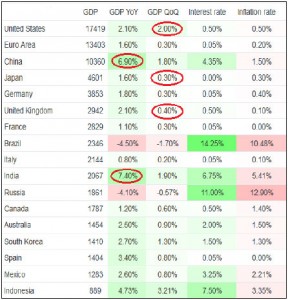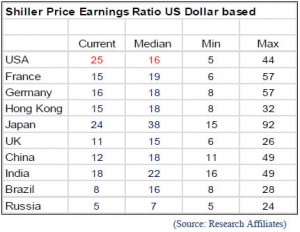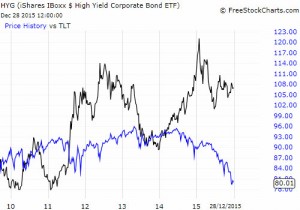2015 proved to be a flat year for investors; the FTSE100 ended the year down by 4.9%, whereas the FT World scraped a positive 2.3%, on a capital basis even Gilts fell by 2.6%. But this was always going to be an unpredictable year.
The end of QE in the USA has now been followed by an increase in the interest rate as the US Federal Reserve Bank attempts to “normalise” the US economy for the first time since the Credit Crunch.
Many see this as a risky move, as apart from the US only the UK of the major economies is reporting good levels of growth. But we need to remember economies are like super tankers, decisions taken now have to be based on what might happen in 12 to 18 months’ time.
In the first half of 2015 markets accepted this and actively looked for the Fed to raise rates, but as ever in the global economy, things changed and markets are now worried that the Fed has moved too early. What changed was that the Chinese economy’s impressive rate of growth slowed further, this has had a direct impact on the US Dollar which has been strong (not good for US manufacturing).
In addition the oil price has continued to fall. The decline of oil, which was initially greeted as good news, as it should ultimately boost consumer spending, has in the short term been detrimental both to the US economy and to share prices of some of the largest companies in the world.
The Fed believes that the US economy is now growing at a healthy rate; this is because unemployment is falling, average wages are increasing, all signs of “normalisation”.
The problem is that many commentators highlight various other data points such as railroad traffic, shipping volumes, lumber volumes etc. and these all indicate a US economy that is not as healthy as the Fed is telling us.
Who is right?
Only time will tell. Oil has been the defining factor in 2015, the Saudis choosing to flood the market with cheap oil has the potential to upset the delicate equilibrium of the global economy. Markets are wary of another “Lehman moment” i.e. when the investment bank Lehman Brothers was allowed to collapse by the New York Fed in 2008 which then set off a chain of interrelated events which threatened the whole US and European banking system and precipitated the Credit Crunch.
A falling oil price does have the potential, via the High Yield Bond market, to cause such disruption.
Geopolitically, the Middle East is looking even more fragile than usual, and a low oil price has the potential to topple regimes.
We also have a US Presidential Election and the Brexit vote to confuse matters even more! So for 2016 the markets are facing headwinds from a number of directions, the real question is ……will they be transitory?
Growth
Source: Trading Economics
Generally speaking most of the growth is still coming from the new world economies. Given all the doom this is a surprisingly healthy table. There is a numerical link between growth, interest rates and inflation. Interest rates should be above the rate of inflation by about 0.5% and growth should also be about 1-2%, for a mature economy, above inflation.
If we ignore the two big oil/commodity countries Russia and Brazil, growth around the world is generally respectable.
The quarterly data is more volatile but nowhere does it suggest recession. Even the laggards, Japan and the Euro area, are not disastrous, just not quite where it should be. Now it is possible that the data could deteriorate from here but it is also just as possible it could accelerate as well! Markets will remain sensitive to each individual data point.
Valuations
Whilst it is good for companies that economies are generating growth, the stock markets are separate.
Whilst they need economic growth to generate ever increasing profits, which can be paid as dividends, for investors to make money from shares, it is generally better to buy them when they are cheap. This is a subject we have covered extensively in previous newsletters.
In the key US market reported corporate profit growth is currently negative and valuations are expensive. But as we have demonstrated before, this is due to the impact that the very large oil companies have on the underlying numbers as they are weighted according to company size.
Whilst it is always dangerous to rationalise an indicator the complexity of what is going on in the global bond and equity markets does warrant further analysis. We need to know what the “correct price” is of the markets we are investing in.
One way we can do this is to look at the Schiller Price Earnings ratio. This averages the earnings per share part of the calculation over 10 years and also adjusts the price part for inflation. This gives us a long term value measure against which we can compare the current valuation. This is important as we are not short term traders, but long term investors.
Japan does stand out as expensive and this is in part due to different accounting policies but also to very high levels of cash that Japanese companies carry. In the new world areas valuations are very low with China, India, Brazil and Russia all close to their long term minimum valuations.
Patience maybe required here but better to buy cheap rather than expensive. A meaningful recovery in the oil price will see the majority (Germany and Japan do not have major oil companies) of these valuations move significantly lower.
Oil
The news that Saudi Arabia would remove self-imposed restrictions on the supply of oil in late 2014 sent the price of crude into a nosedive.
Initially this was greeted as good news as it would act as a stimulus to global growth via increased consumer spending.
But in the short term it has delivered more bad news than good, a fall in demand for bulldozers, pumps, pipes and all the other paraphernalia associated with oil production which has hit the US Durable Goods statistic. Then we have the previously mentioned collapse in the profits of Exxon, Chevron, BP, Shell, Eni and Total etc. Recently the OPEC price cartel has given up all efforts to set the price and oil is being left to the market to find the correct level.
The problem for the Saudis is that fracking and shale has meant that US custom for Saudi oil has declined at a time when Russia is still pumping as sanctions bite and Iraqi oil has come back onto the market.
Then we can add in the black market oil from war torn Libya and Syria/ISIS Iraq, plus the imminent supply from Iran as sanctions are lifted on Iranian oil exports. Therefore there is simply significant excess supply compared to demand, so the price must fall.
Storage tanks around the world are full to the brim and tanker charter rates are booming. Far from shipping oil around the world super tankers are being used as temporary (hopefully) floating storage facilities. Whilst refineries are “making hay” reports suggest that tankers full of refined gasoil (diesel) are circling in the Atlantic with as yet no customers.
Economic theory suggests that the oil price must continue to fall until capacity is cut, or demand picks up. The Saudis hoped that the US shale producers would have gone bust by now; they haven’t, but may well yet do so.
However, this is an election year in the USA. Many poorer states have boomed from the growth in domestic oil production, if oil becomes an election issue then a protectionist US stance would backfire on the Saudis.
If the Saudis and Iranians do escalate their mutual hatred and the Straits of Hormuz are closed then oil’s price decline could rapidly be reversed. There is a new King and Crown Prince in Saudi Arabia and they appear to be more belligerent than the older Regent.
There are severe financial consequences for the Saudi finances from this lower oil price which bring with it domestic risks, a recent Saudi budget saw some significant cuts in government expenditure.
There must be a similar impact in the United Arab Emirates as well. Reports suggest some Middle East selling of western assets is taking place to generate cash.
A debt default, in this region would not be good news, remember some state owned Dubai entities were bailed-out by Abu Dhabi during the Credit Crunch. This is one area of the world where we could see the risk of the dreaded contagion.
Western banks have been cutting back on their exposure, but it must still be significant? Could the London West End “trophy” property market cope with some forced Middle East selling?
High Yield Bonds
This means the credit rating agencies award such companies a very low rating, or even none at all, this is then known as “Junk”. In order to attract investors this means they have to offer a high yield compared to either government or blue chip corporate bonds.
With interest rates so low, high yield bonds have become attractive to investors seeking income. The problem is that they are very hard to deal in. Sellers could find themselves with no buyers at any price. Default rates are starting to pick up, particularly from small US oil companies.
Holders may yet decide to rush for the exit, (there are already some signs of this happening) but could find themselves trapped.
The above Blue line shows the price of the High Yield ETF in the USA. The Black line is the US Government Treasury Bond ETF.
An ETF is an Index Tracking Fund that can be bought and sold on the US stock exchanges. There is a very complex way that such funds are priced and the underlying assets bought and sold, but ultimately for any sale there has to be a buyer found for the underlying asset.
The problem is that this fund is worth $14.4 billion and is just one of many. No one really knows what the capacity of the market is for all of these high yield assets, but with big investment banks no longer allowed to hold bonds and shares for their own trading account it would appear to be limited. Worryingly, there is also the practice of “hypothecation”, a big word which essentially means using an asset such as this ETF as collateral to borrow money to finance another trade.
The high yield makes such a practice financially very attractive, the coupon received was greater than the interest paid!
Whilst the Fed was buying bonds it was an easy trade, but not if the high yield bond market is full of sellers and no buyers. The holder of the collateral may just choose to call in the debt, thus adding to the queue of forced sellers.
Therefore, one small bond default can have an impact way beyond its initial financial value. Some bond focussed hedge funds are closing; this may be a storm in a teacup but if defaults increase, then so do market risks.
Brexit
After decades of avoiding talking about the EU the Conservatives gambled on an IN/OUT referendum manifesto promise in order to fend off the then perceived threat of UKIP. At the time this may have been an acceptable risk for Cameron to take but it may just backfire on him?
He has gone to the EU to renegotiate the UK’s role in Europe but seems only to be trying to do an opt-out on Child/Working Tax Credits for EU citizens in the UK.
This seems to be a pretty small agenda to base a referendum on? Also he is in danger of reopening long standing splits within the Conservative Party and all of this is at a time when the Syrian refugee crisis and the Paris terror attacks are threatening European freedom of movement and possibly moving public opinion against an IN vote.
The bookies odds (more accurate than the polls) still suggest that the IN vote will win. For the UK economy no-one has as yet published a truly convincing analysis of the financial impact on UK plc from a Brexit.
In reality they can’t, as it depends upon the terms of the exit and of the ensuing trade agreement (if there is one). So we have the dreaded uncertainty, but markets will not price this in until Cameron sets a date.
It may well be that he drags he feet and waits and sees how the Middle East conflict develops and thus the refugee crisis.
US Presidential Election
2016 sees the election of a new President to replace Barrack Obama.
At the moment each of the two main parties are seeing their various candidates jockeying for position in the hope of securing a nomination. For the Democrats, as we write, Hilary Clinton seems to be the most likely candidate, for the Republicans it is not at all clear as to who their candidate is likely to be.
Donald Trump appears to be winning in the opinion polls, though the bookies have him behind Marco Rubio. Anything could happen in American politics, and we have learnt from elections elsewhere that social media, such as Twitter, does distort the perception of public opinion.
When it comes to the actual voting, whether it is UKIP in the UK or the Front National in France, media profile rarely matches actual votes.
The general rule of thumb is that the Republicans are friendlier for stock markets. Obama lost both Houses of Congress and has been unable to stimulate the US economy through budget measures. A Republican President would probably have both Houses as well and thus could pick up the baton from the Fed as the main stimulator of the US economy.
Investment Strategy for 2016
So what are we looking for in 2016? Well the basic facts are that the current level of growth around the world is fine, would be nice if it was better, but then it keeps inflation under control and thus interest rates low.
We are concerned though that we keep getting bits of data, particularly from the US, which suggests growth might be slowing.
If this continues then the US might slip back into a mild recession.
This would not be disastrous in the long term scheme of things just not welcome. Europe seems finally to be picking up and this may be enough to counteract any slowdown in the US, should it occur.
China had been the cream on the top of global growth, it is restructuring, just as Britain and America did in the 1980s from a manufacturing, export economy to a service based consumer-led economy.
This move is causing disruptions and China is devaluing its currency. But China still has the largest and fastest growing middle class in the world (followed by India) this fact alone makes the probability of success for this strategic change high.
So there is reasonable growth around the world but, the US might be slowing, Europe is picking up and China for now is the great unknown.
For those economies that rely on oil and or commodities such as Australia, Canada, Brazil, Russia and Saudi Arabia 2016 could be very tough year.
Valuations as we have seen (with the exception of the USA) are reasonable and equity dividend yields relative to inflation are spectacularly high, compared to historic averages. This underwrites the growth potential from equity investments.
The cycle, in terms of time, is getting mature, but is certainly not mature in terms of inflation and growth, we have barely got going!
There remains huge scope for improvement, especially from the US consumer. For now, we also have a number of “risk events” occurring this year. The Presidential election and Brexit referendum are two; Syria/Saudi Arabia and Iran are another.
Any one of these events has the potential to cause a market shock, but could just as likely pass off smoothly.
In terms of client portfolios we have already taken steps to reduce the risk profile of our Cautious investments which are invested in Gilts and Bonds.
This has moved this section towards the lower risk end of the scale. In Balanced investments we have moved out of
index tracker funds which track the markets down as well as up. Oil will be the key to 2016.
Markets
Markets over the long term go up in a consistent uptrend, but in the short term this trend is made up of periods of volatility with equity prices typically swinging by around 15-20%. The QE period has dampened this volatility, it has not been normal.
With QE ending in the US and interest rates increasing we must expect normal service and thus volatility to be resumed. 2016 looks like it might be a difficult year, but this will just be a small chapter in the long term journey that is investment.
It will pass and the trend will yet again re assert itself.
December 2015
Click Here for Printable Version






